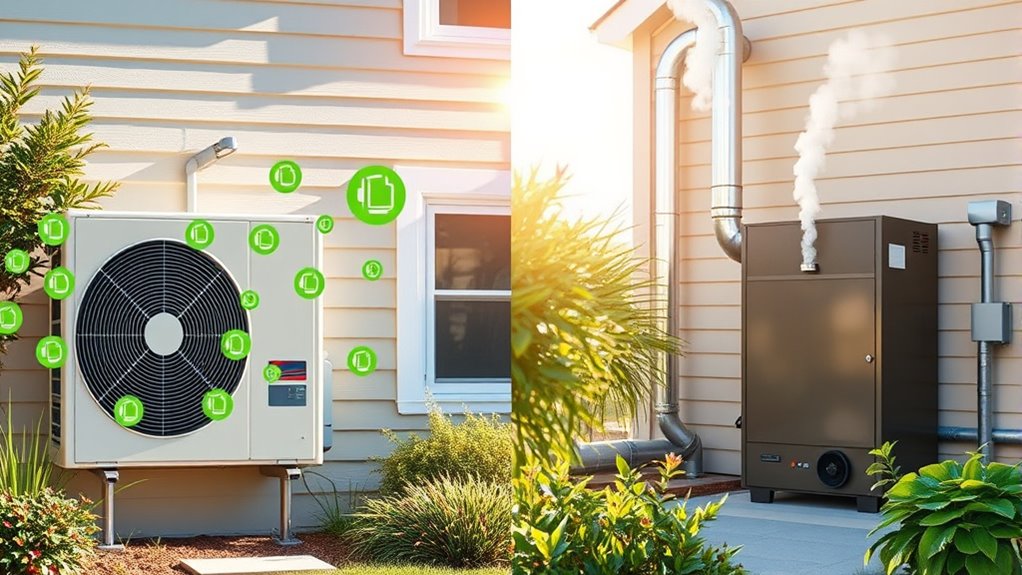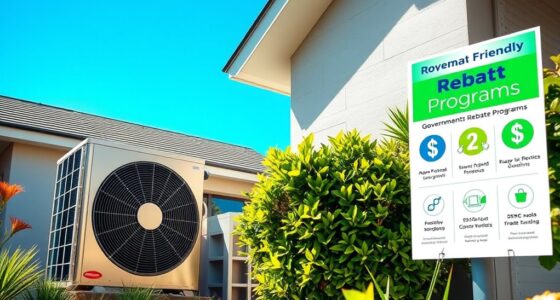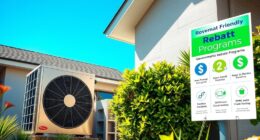Heat pumps usually cost $4,000 to $8,000 to install, with ground-source options adding $10,000 to $30,000, while traditional electric systems cost under $2,000. Although they have higher upfront costs, heat pumps save you money long-term through lower energy bills and incentives that can cover up to half of the costs. Plus, their durability and environmental benefits make them a smart choice—if you’re curious about more savings and details, keep exploring.
Key Takeaways
- Heat pumps typically cost $4,000-$8,000 to install, while traditional electric systems are under $2,000.
- Initial costs for heat pumps are higher but offset by energy savings and incentives over time.
- Operating costs for heat pumps are up to 50% less than traditional electric or fossil fuel systems.
- Maintenance for heat pumps is generally lower, with a lifespan exceeding 20 years, compared to 20-25+ years for resistance heaters.
- Incentives and property value increases enhance the financial benefits of choosing heat pumps over traditional systems.
Initial Investment and Installation Expenses
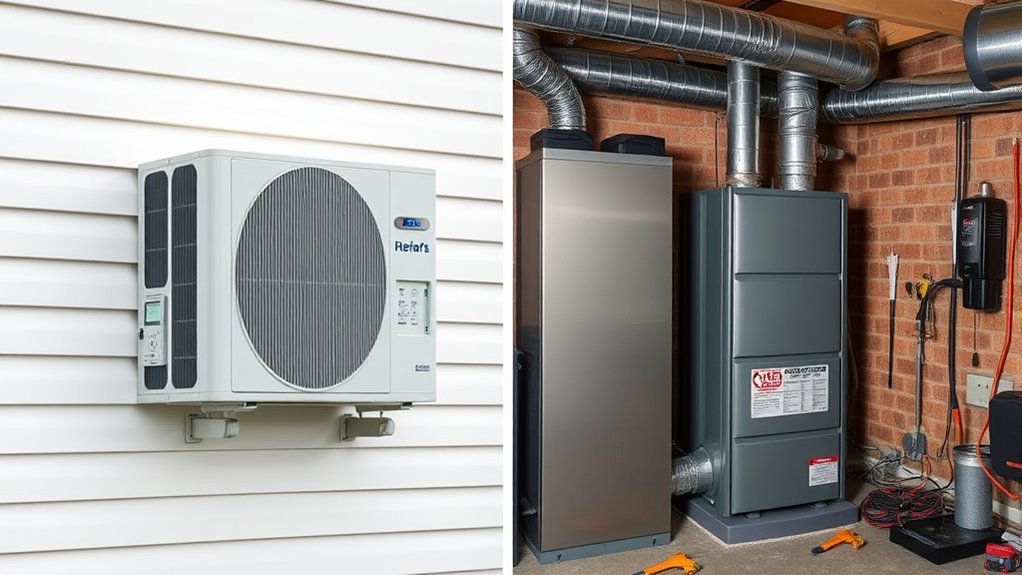
When comparing initial costs, heat pump systems generally require a higher investment upfront than traditional heating options. The installation costs for heat pumps typically range from $4,000 to $8,000, depending on system type and home size. Ground-source heat pumps involve extensive trenching and underground piping, adding $10,000 to $30,000 to expenses, making them more costly initially. Air-source heat pumps are usually less expensive, with installation costs around $3,500 to $7,500, involving outdoor units and refrigerant lines. In contrast, electric resistance heating systems, like baseboards or electric furnaces, often cost under $2,000 to install. While upfront costs are higher for heat pump systems, their energy efficiency can lead to savings over time, especially with available incentives and rebates. Furthermore, the initial investment can be offset by long-term operational savings and environmental benefits. Additionally, considering maintenance costs over the lifespan of the system can provide a more comprehensive understanding of overall expenses.
Ongoing Energy Consumption and Operating Costs
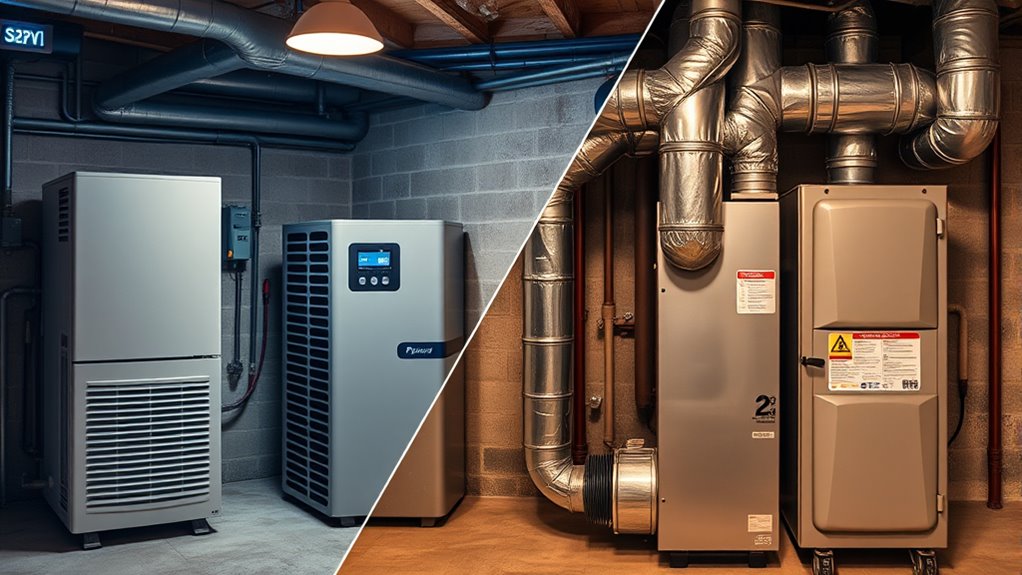
While heat pumps may require a higher initial investment, their lower ongoing energy consumption can lead to significant savings over time. Their efficiency translates into notable energy savings, lowering your operating costs. Consider these points:
- Heat pumps typically use as little as $0.05 per kWh, reducing electricity expenses compared to traditional electric resistance heaters.
- Operating costs for heat pumps can be up to 50% less than traditional heating systems due to higher efficiency, with SEER ratings up to 23.
- In moderate climates, heat pumps deliver 3-4 units of heat per unit of electricity, further decreasing energy consumption.
- During cold weather, ground-source heat pumps maintain consistent low operating costs, while air-source models may see efficiency drops, increasing energy use.
Maintenance Requirements and Long-Term Durability

Heat pumps have fewer moving parts, which means they generally need less maintenance and tend to last longer. With routine tasks like filter replacements and coil cleaning, you can keep them running efficiently for over 20 years. In contrast, traditional systems may require more frequent inspections and part replacements to stay durable. Additionally, their protective styling benefits can help extend the lifespan of the components by reducing wear and tear. Moreover, the simpler mechanical design of heat pumps can contribute to reduced repair costs, making them a cost-effective choice over time. Practicing self-awareness by understanding your system’s needs can also help in maintaining optimal performance and longevity.
Fewer Moving Parts
Fewer moving parts in heat pumps mean they are less prone to mechanical failures and generally require less maintenance over their system lifespan. This simplified design offers several advantages:
- Reduced likelihood of mechanical failure, enhancing reliability.
- Lower maintenance costs due to fewer components needing servicing.
- Increased durability, helping the system last longer without major repairs.
- Consistent performance over time, as fewer parts wear out or break down.
- The streamlined design can also contribute to cost savings by reducing the need for extensive repairs and replacements.
- Additionally, the reduced complexity lessens the impact of wear and tear, further improving system longevity.
- By having fewer parts that are subject to mechanical wear, heat pumps tend to maintain their efficiency longer over their lifespan.
- Incorporating preventative maintenance strategies can further extend the operational life of heat pump systems.
- Regular inspections and timely servicing of these fewer components can further optimize their performance and lifespan.
Longer Lifespan Expectancy
Thanks to their simpler design with fewer moving parts, heat pumps often last longer than many traditional heating systems. The typical lifespan exceeds 20 years with proper maintenance, offering good reliability and durability. However, electric heaters can last even longer—over 20 to 25 years—often with fewer repairs, which reduces maintenance costs over their lifespan. While heat pumps may require component replacements, like compressors or refrigerant lines around 10-15 years, these are manageable with routine inspections. Additionally, system reliability plays a crucial role in overall longevity, as well-maintained systems tend to perform better over time. Incorporating quality components can further enhance system durability and performance. Overall, electric heating systems tend to have a longer lifespan and lower repair frequency, making them a more cost-effective choice for long-term durability. Suction power is a key factor in the efficiency of some systems, affecting their ability to maintain consistent performance over time. Reliable performance standards help ensure these systems function effectively for extended periods, minimizing costly repairs and replacements. Additionally, selecting systems with proven longevity can contribute to energy efficiency, reducing operational costs over the years. By choosing systems with proven longevity, you can maximize your long-term savings and minimize unexpected repair expenses.
Routine Maintenance Needs
Routine maintenance is essential to keep heating systems operating efficiently and extend their lifespan. For heat pumps, this involves:
- Performing annual filter replacements to maintain airflow and efficiency.
- Conducting periodic system checks to identify potential issues early.
- Monitoring for component wear, which can affect overall performance over time.
- Understanding that regular maintenance helps reduce long-term repair costs and keeps the system running smoothly.
- Incorporating personalized work environments can also improve maintenance routines, making tasks easier and more efficient.
- Recognizing that consistent upkeep can enhance the system’s resilience against environmental challenges and prolong its service life.
- Using advanced diagnostic tools can help detect early signs of system degradation, ensuring timely interventions.
Compared to electric resistance heaters with fewer parts, heat pumps require more upkeep but tend to have lower long-term repair costs because of their fewer mechanical components. Well-maintained heat pumps can last over 20 years, making routine maintenance a worthwhile investment in their durability and cost-effectiveness.
Cost Efficiency in Different Climate Conditions
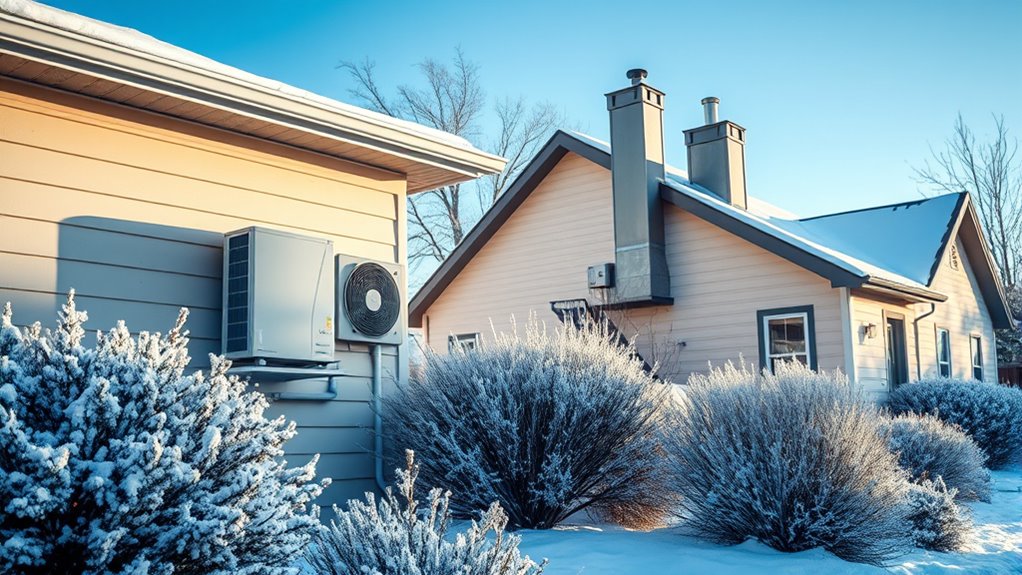
The cost efficiency of heat pumps varies considerably depending on climate conditions. In moderate climates, heat pumps can deliver up to four times the energy output per dollar compared to traditional systems, making them highly cost-efficient. Cold-climate heat pumps are designed to operate effectively down to -15°F to -30°F, maintaining good efficiency even during harsh winters. However, as outdoor temperatures fall, the COP of air-source heat pumps decreases from around 3.0 to about 2.0, increasing operating costs slightly. Ground-source heat pumps, or geothermal systems, keep their efficiency steady regardless of outdoor temperatures, often making them the most cost-effective choice in extreme cold. In prolonged cold seasons, propane or oil systems might become more economical due to reduced heat pump efficiency. Additionally, the presence of seasonal temperature variations can significantly influence the overall cost-effectiveness of different heat pump systems, especially when considering energy management technology to optimize performance. Moreover, advancements in heat pump technology continue to improve efficiency across various climates, broadening their applicability and potential savings. Improvements in refrigerant systems also enhance performance and reduce environmental impact, making heat pumps an increasingly sustainable option. Properly integrating these systems with smart home controls can further enhance energy savings and operational efficiency.
Environmental Benefits and Incentive Opportunities
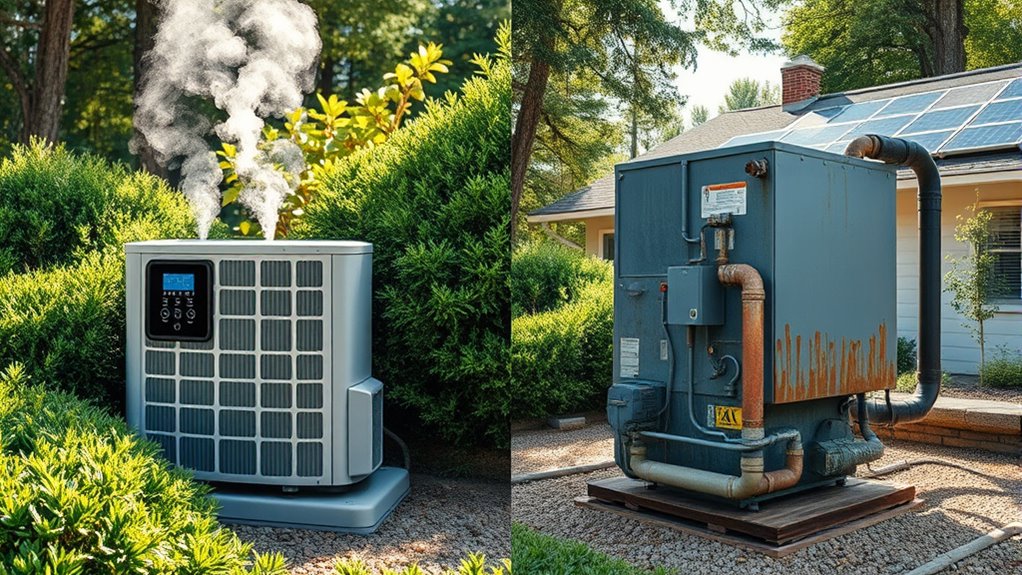
Switching to a heat pump helps you cut your carbon footprint, especially when powered by renewable energy. Many states offer rebates and tax credits that make this upgrade more affordable. Plus, using cleaner energy supports your sustainability goals and takes advantage of financial incentives like those from the Inflation Reduction Act. Incorporating renewable energy sources into your system further enhances these environmental benefits and maximizes potential savings. Additionally, the adoption of private placement equity markets in the energy sector can provide funding opportunities for large-scale renewable projects that support these initiatives.
Reduced Carbon Footprint
Choosing a heat pump instead of a traditional fossil fuel system can substantially lower your home’s carbon footprint. Heat pumps produce markedly fewer greenhouse gas emissions, helping you reduce your environmental impact. When you switch to a heat pump, you benefit in several ways:
- They cut your carbon footprint by up to 50% or more, depending on your electricity source.
- Modern models can incorporate renewable energy like solar or wind, further lowering emissions.
- Incentive programs often favor electric heat pumps, making the switch more affordable.
- Widespread adoption supports national climate goals by decreasing reliance on coal, oil, and natural gas for heating.
- The integration of renewable energy sources enhances the environmental benefits of heat pumps even further.
Renewable Energy Integration
Ever wondered how integrating renewable energy sources can boost your heat pump’s environmental benefits? When you power heat pumps with renewable energy like solar panels or geothermal, you markedly cut carbon emissions and promote sustainable heating. Many modern heat pumps already incorporate these sources, making your system greener. Incentive programs, such as federal tax credits and state rebates, encourage adopting renewable-integrated heat pumps. Ground-source (geothermal) heat pumps tap into natural underground heat, providing a consistent renewable energy source. By switching to electric heat pumps powered by renewables, you can reduce your home’s carbon footprint by up to 70%. Here’s a quick comparison:
| Renewable Energy Source | Environmental Impact |
|---|---|
| Solar panels | Reduce reliance on fossil fuels |
| Geothermal | Offers consistent renewable heating |
| Grid with renewables | Lowers overall carbon emissions |
| Fossil fuels | High emissions, less sustainable |
| Traditional systems | Less environmentally friendly |
Financial Incentive Opportunities
Integrating renewable energy sources with heat pump systems not only benefits the environment but also opens up significant financial incentives. Many states and utility companies offer rebates and incentives that can cover up to 50% of installation costs, easing your upfront investment. Federal tax credits, like those from the Inflation Reduction Act, can provide rebates of up to $8,000 for qualifying systems, further reducing expenses. Additionally, installing a heat pump with solar or wind integration qualifies you for renewable energy incentives, boosting long-term savings. Incentive programs often require energy audits, encouraging you to improve overall home energy efficiency. Here are some key opportunities:
- Rebates covering a large portion of installation costs
- Federal tax credits for energy-efficient upgrades
- Incentives for renewable energy integration
- Programs promoting energy audits and certifications
Overall Cost-Effectiveness and Property Value Impact
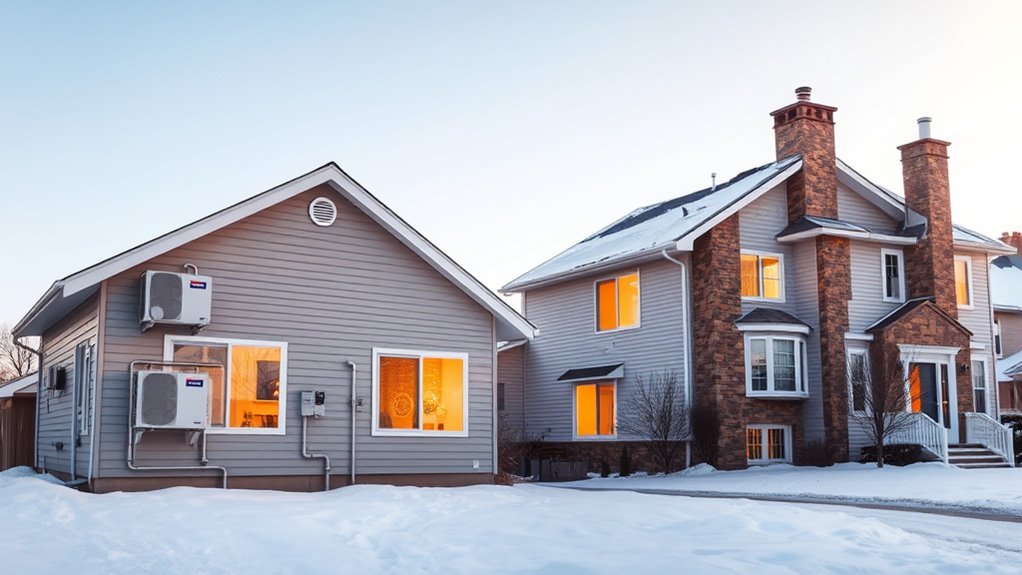
Heat pumps offer a compelling balance between upfront costs and long-term savings, making them a cost-effective upgrade for many homeowners. Their high energy efficiency can boost property value by approximately 3-5%, attracting environmentally conscious buyers. While the initial investment may be higher, the long-term savings on energy and maintenance costs often offset this expense. Plus, homes with heat pumps qualify for incentives and rebates, further enhancing overall property value and appeal. Durability and longevity—exceeding 20 years with proper care—add to the long-term worth of your investment. Installing a heat pump not only improves your home’s energy efficiency but also enhances its marketability, making the progression a smart choice for both your wallet and the environment.
Frequently Asked Questions
Do You Really Save Money With a Heat Pump?
Yes, you can save money with a heat pump. It’s designed to be more efficient, which means lower energy bills over time. Even though the upfront cost might seem high, rebates and reduced operating expenses help offset that initial expense. Over its lifespan, a heat pump can save you up to $1,500 annually, making it a smart investment for your home and your wallet.
What Is the Major Disadvantage of a Heat Pump?
The major disadvantage of a heat pump is its reduced efficiency in extremely cold temperatures. When outdoor temperatures fall below around 5°F, your heat pump struggles to maintain warmth, leading to higher energy use and costs. You might need supplemental heating sources, which can increase expenses. Cold climates also may require additional equipment or upgrades, making the overall system less cost-effective and more complex to operate.
Which Is Cheaper to Run, a Heat Pump or a Furnace?
You might find that a heat pump is more economical to run than a traditional furnace, especially in moderate climates. Heat pumps use energy transfer, making them typically cheaper at about $29.31 per million BTUs, compared to fossil fuel-based systems. During milder weather, they operate efficiently, reducing your monthly costs. However, in colder regions, traditional furnaces could be more cost-effective when temperatures drop considerably.
Why Is My Heating Bill so High With a Heat Pump?
Your heating bill might be high because your heat pump isn’t operating efficiently. Cold outdoor temperatures can reduce its performance, making it work harder and use more electricity. Poor insulation or air leaks can also cause it to run longer. Additionally, if your system is outdated, improperly sized, or poorly maintained with dirty filters or clogged coils, it’ll use more energy, driving up your bills. Regular upkeep can help keep costs down.
Conclusion
When weighing heat pumps against traditional heating, think of your decision as planting a tree—initial costs may be higher, but the long-term benefits grow steadily. While installation and maintenance costs vary, the savings on energy bills and environmental perks make heat pumps a smart investment. Ultimately, choosing the right system can transform your home into a haven of efficiency and sustainability, turning your heating choice into a foundation for a greener future.
